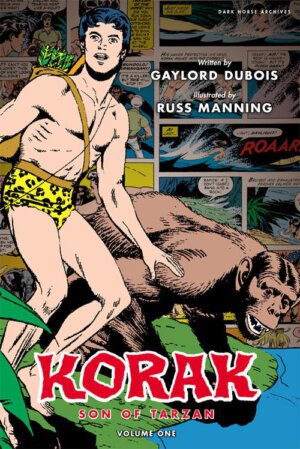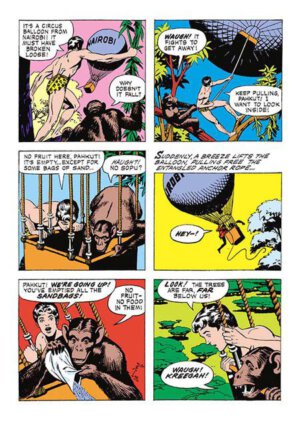
Publisher: Dark Horse Comics
Writer: Gaylord DuBois
Artist: Russ Manning
Cover Art: Mo Gollub
Pages: 192
Format: Hardcover
Retail Price: $49.99
Dark Horse continues their archival record of Tarzan with the publication of the first volume of Korak, Son of Tarzan from 1964. The six issues reprinted, written by Gaylord DuBois and drawn by Russ Manning, were originally published by Gold Key comics – king of the licensed comics of the ‘60s – are…well…most definitely products of 1960’s Gold Key. Now that’s not to say that they’re bad, just that, as Steve Rude points out in his introduction, they’re definitely a product of a different time.
The collection does not start off strong at all. Now it’s possible that some people, more familiar with the movie Tarzan’s Boy character rather than the novel-derived Korak, would be a little confused by the Son of Tarzan moniker, and since this is a Tarzan spin-off, it’s nice to have daddy guest star in the first issue; but unfortunately, after a clumsy introduction of the Tarzan family (typical dialogue – Tarzan: “Korak is as near as our ape friends can come to saying Jack, which is our son’s given name.” Thank you Basil Exposition.), Korak is immediately captured and becomes a supporting player in his own book as Tarzan comes to his rescue. I was a little worried at first that this would be a typical storyline, repeating itself and being as predictable as an episode of Scooby Doo, but luckily the very next story is much more entertaining and focused on Korak, who stumbles upon miners using natives as slave labor, battles a territorial gorilla, and has to use his considerable survival skills to battle evil. Not a Tarzan to be seen.

The remaining stories in the book certainly run the gamut from the mundane (poachers!) to the fantastic (man-eating giant vulture gods with their kidnapped white priestess!). My favorite story is “Wizard’s Gorge”, a tale of a witch doctor who tries to scam natives by healing using White Man’s Medicine while wrapping it up in the trappings of mysticism, such as injecting patients with a hypodermic needle while sitting under a smoke-filled skeleton of an elephant. It’s a cute idea, and Korak’s line when dismissing the ranting witch doctor, “The hyena raves…but who listens?” is one I plan on adding to my every day conversations. Unfortunately, we learn that Korak also speaks fluent baboon in addition to the half dozen or so other languages he speaks. *Sigh* Talking animals.
Overall, the collection is on the correct side of fun, but it doesn’t have much of a spark to make it a must buy. It has its moments, it sometimes drags and feels tedious, it’s not in the least bit complex or thought-provoking…but sometimes simple is good. If you’re looking for simple adventure, this will work for you.

















